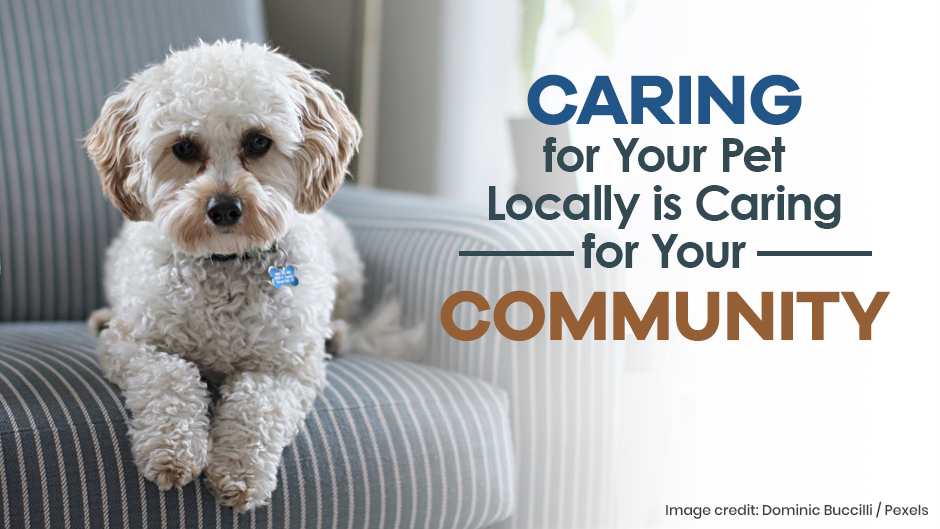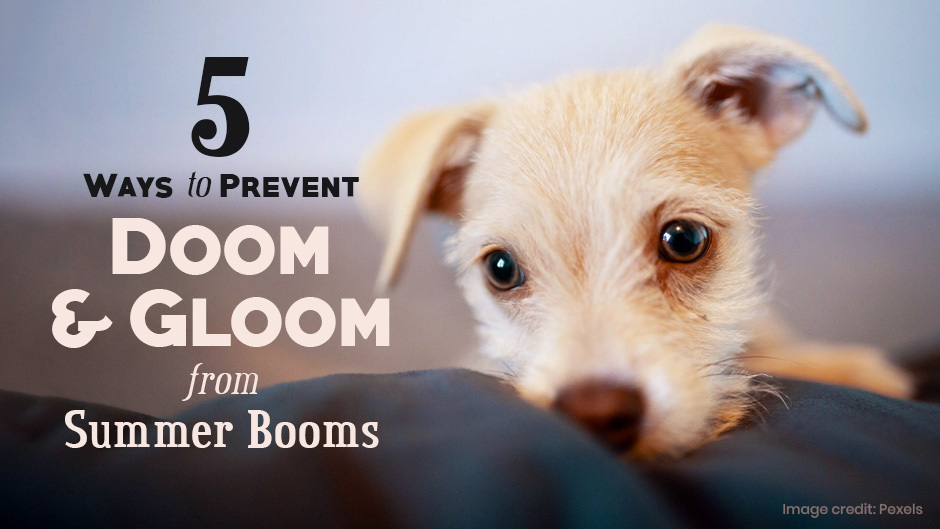Our Blog & Pet Health Topics

Caring for Your Pet Locally is Caring for Your Community
We’re proud to be part of this diverse and caring community. We are equally honored to be a local business that makes an impact on the happiness and health of your furry family members.
During these trying times, we have remained open to provide pets with the medical care they need. We’re proud to continue to serve you and provide critical veterinary services to our community.
As the effects of COVID-19 provide challenges to small businesses, choosing local providers for your purchases and services is vital to our area’s economy. If you’re thankful for being part of this community, we hope you’ll keep your shopping trips local as a way of caring for our region.
Why Use Small Businesses and Why Shop Local?
When you patronize local small businesses, you improve our community. How? Shopping locally increases employment opportunities, provides better wages to employees, and keeps your money benefiting our community through taxes and employee payroll.
What Can You Do to Increase Your Local Impact as a Pet Owner?
1. Provide Your Pet with Veterinary Care from a Small Business
We know many people are choosing which services and errands to go without due to COVID. Providing your pet with veterinary care is not something to skip. Nobody knows how long this pandemic will last, and postponing your pet’s appointments could be disastrous.
Scheduling your pet in for their regular check-up or a health concern helps us continue to maintain our staff and helps your pet. Early diagnosis increases the effectiveness of treatment and often decreases the medical intervention needed. Preventative medicine and regular exams reduce your vet bills in the long run and improve your pet’s prognosis should they fall ill.
Don’t remember the last time your pet was vaccinated? August is National Immunization Month, so it’s a good time to check if your companion is due for these vital vaccinations to help keep them healthy.
2. Let Us Fill Your Pet’s Prescriptions Instead of a Big-Box
One often-overlooked opportunity to keep your dollars in our community is to fill your pet’s prescriptions with us at our online store. Studies show that using a big-box retailer can hamper local economic growth. If you go elsewhere for your pet’s medicine, including heartworm, flea, and tick prevention, we hope you’ll consider transferring their prescription to us. We offer convenient means to fill your pet’s Rx, provide you with advice and guidance, and are a trusted source for your pet’s medications.
3. Don’t Skip Veterinary Care for Your Cat
Did you know that August 22nd is Bring Your Cat to the Vet Day? Make an appointment to support your cat’s health and a local veterinarian. Cats often go longer than dogs without visiting the vet, because they often seem more self-sufficient but, in fact, are really masters of hiding pain and discomfort. If it’s been a while since your cat had an exam, call or text 817-727-7107 to make an appointment with us.
4. Follow Us on Social Media & Share Posts
Following our practice and other local pet-related businesses on social media are easy ways to pay it forward without spending any money. If you like one of our posts, why not share it with your network? We appreciate those who spread information that improves the lives of pets beyond our reach, and social media is a way to connect your friends and family to a great local business.
5. Refer a Friend
The power of word-of-mouth has never waned. If you have a friend or family member looking for veterinary care, we hope you’ll send them to us. We appreciate your referrals and love meeting new people and their pets. Plus, your friend will appreciate the peace of mind of knowing their pet will be cared for by people you already trust.
6. Review Us Online
We hope you’ll take the time to review us and other small local businesses on Google and Facebook. Your positive experience can help a pet parent looking for quality care. Taking a moment to tell your neighbors about why you trust us with your pet’s health highlights a local business and keeps our community ties strong.
Thank You for Choosing Us to Care for Your Pets
Struggling retailers, caring providers, and your favorite restaurants need you now more than ever. We love this community: the people, the pets, and the spirit, and we hope to see it thrive in the face of adversity. You’re in our hearts and on our minds. Stay safe and healthy, and we hope to see you soon.

3 Hidden Summer Hazards That Can Be Fatal for Pets
The dog days of summer are here. For many, this season comes with endless possibilities for having fun with your pets, like picnics, nature walks, and swimming pools. After being stuck at home for so long due to COVID-19, we bet you’re looking to break up the boredom with some outdoor adventures.
As temperatures rise, so do the risk factors for heat and summer-related dangers. We want to share with you some of the hidden hazards associated with summer activities that pets and their owners adore.
1. Blue-Green Algae
If you’re like many dog owners, you plan your summer walks to include a water source for your hiking buddy to cool off and rehydrate. Staying cool and drinking enough is vital during these scorching hot days, but many of our freshwater ponds and lakes host a deadly and dangerous toxin: blue-green algae.
What are blue-green algae? It’s not a form of algae at all, actually, but a microscopic bacteria called “cyanobacteria.” These bacteria thrive in water sources when temperatures reach 75º or warmer.
What you see as “pond scum” is more than just gross – it’s deadly. Blue-green algae are highly toxic for pets when ingested, leading to seizures, neurological damage, liver failure, and death. Most frightening of all, dogs and cats often die within hours of becoming poisoned.
How can pet owners protect their pets from this deadly bacteria? Never let your dog or cat drink from a water source that has green scum floating on top or near the shoreline. This includes pools and garden ponds.
While you’re out on the trail, provide your pet with fresh, cool water from home. Rinse your dog off if they go for a swim. They could later ingest blue-green algae that cling to their fur and become very sick.
Don’t let your pets explore freshwater ponds and lakes unsupervised. When in doubt, keep your dog out.
2. Leptospirosis
Leptospirosis is another bacterial threat, but it cannot be seen with the naked eye. This bacterial disease has been on the rise as temperatures climb. We know the last thing you want to think about is another zoonotic disease, but leptospirosis can affect pets and humans.
Leptospirosis is caused by spring-shaped bacteria that can be found in water and soil and is commonly spread through urine. The bacteria are picked up from a pet drinking contaminated water, or sniffing or digging in an area where an infected host urinated.
Once inside your pet’s body, leptospirosis causes flu-like illness and can damage the kidneys, liver, and other organs. Young pets, senior pets, and those with weakened immune systems are at risk of dying from leptospirosis.
What areas are high-risk zones? Leptospirosis infects domestic and wild animals. Your pet risks contracting this disease at the dog park, in your yard, and almost anywhere an animal could urinate.
Protect your pet by not letting them drink from unknown water sources, preventing them from exploring areas where mice, rats, and other wild mammals frequent, and asking us about the leptospirosis vaccine.
3. Hot, Hot, Heat Stroke
Each year dogs and cats die from heat stroke. This hidden killer is heartbreaking because many pet owners don’t realize their pets are at risk.
Also known as hyperthermia, heat stroke happens when the body is too hot for too long. Heat stroke occurs frequently with pets because dogs and cats cannot regulate their temperature through sweat, relying on other means such as panting or lying on a cool surface. When they’re on a hike, locked in the car, or fenced in the backyard, these methods may not be enough to bring their body temperature down to a safe level.
Heat stroke is extremely dangerous, leading to stroke, organ failure, and death. Some pets are more susceptible to heat stroke than others, such as dogs and cats with short snouts, senior or overweight pets, and those with thick coats.
To keep your pal from reaching an unhealthy temperature, supply them with ample cool, fresh water. (Are you seeing a pattern yet?) Always provide them shade when outdoors. Watch for signs of overheating like excessive panting, shivering muscles, and weakness. Don’t let your pet exercise in the middle of the day when temperatures are the highest. And NEVER leave a pet in your car.
What should you do if you suspect your dog or cat is overheating? Immediately bring them inside to an air-conditioned location and provide them with cool water. Hose them down or put them in the shower, using room-temperature water. Do not use cold water, which can send them into shock. Wrap them in a damp towel, call us, and bring them in.
Don’t Let These Summer Hazards Turn Your Summer into a Bummer
Make a splash, have a blast, and keep the fun in summer fun! Protecting your pet takes a bit of proactive planning but can be the difference between life and death. We hope these tips help keep your furry family members safe all summer long.

5 Ways to Prevent Doom & Gloom from Summer Booms
Does your dog or cat run and hide when there’s a thunderstorm? What about the Fourth of July? Between unpredictable weather and fireworks, your pet may be dreading summer.
While your pet hides, shakes, and drools, there’s a good chance you’re also unable to relax from worrying about them. We’re here to assure you that it doesn’t have to be that way.
How Can I Reduce My Pet’s Noise Anxiety?
Imagine you’re a dog or cat. Yes, this sounds silly, but try it. Take a moment and lie beside your canine companion or feline friend on the floor. The world looks a little different from this angle, right?
Now, imagine you’re relaxing, thinking about treats and toys, when all of a sudden you feel the floor, walls, and furniture shake. There’s a change of pressure in your ears, and maybe you even notice a flash of light reflecting off the window. Pretty scary, right?
If Independence Day is more like co-dependence day as you worry and fret over your pet, these techniques can help them find their happy place this July Fourth.
1. Make an Appointment to See Us
If your dog or cat suffers from anxiety caused by loud noises, we can help find a medication to help them feel better. Having a prescription on-hand ready before a summer storm or fireworks can make a world of difference for a fearful pet.
Don’t wait too long to make your appointment since we tend to book up quickly right before July Fourth. A bit of extra time can also help us assess how well a medication works for your pet.
2. Provide Your Pet with a Calm Respite from the Noise
If your dog or cat runs for cover, give them the perfect place to run to. Their instinct to hide can be used as a way to provide your pet a routine and stability when they feel like the world is exploding just outside the front door.
Choose a spot your pet can access on their own. A few days before the Fourth of July, make this space comfy-cozy and relax in there with your pet. This will help familiarize them with their safe spot. Play calming music to help drown out the blast and booms, turn the lights off or down, and create a nest of blankets, toys, and some treats.
3. Calming Aids to the Rescue!
There are a lot of options when it comes to calming supplements and products. Some that work well for a lot of cats and dogs include
- Anti-anxiety jackets (they help about 80% of dogs)
- Feliway for cats and Adaptil for dogs
- Vetoquinol Zylkene for cats and dogs
4. Help Your Pet Release Pent-Up Energy
If you check the forecast and storms are predicted or if you’re prepping for July Fourth festivities, take time to provide your pet with a healthy outlet for their energy. For example, playing with your cat for two twenty-minute sessions or walking your dog on a new trail. Exercise and stimulation can release positive endorphins in your pet’s brain and help them better cope when it’s less calm later on.
5. Stay Home This Year
Staying home instead of going out can help your pet feel better, and it may be a good idea to avoid crowds this year anyway. Close the curtains and have your own Fourth of July celebration with just your immediate family. Make a nice dinner and dessert and watch a movie or play board games. Your pet will appreciate your company, and you can monitor how well they’re doing.
Don’t Let the Blasts Make Summer a Disaster for Your Pet
Noise fear and anxiety aren’t fun for pets or their people. You’re not alone when it comes to your pet. We’re here to help make this year the best Fourth of July for you and your pet.
If you’ve been wondering about supplements, prescription medications, or techniques to help your pet gain relief from noise anxiety, make an appointment to see us soon.
Image credit: Pexels
